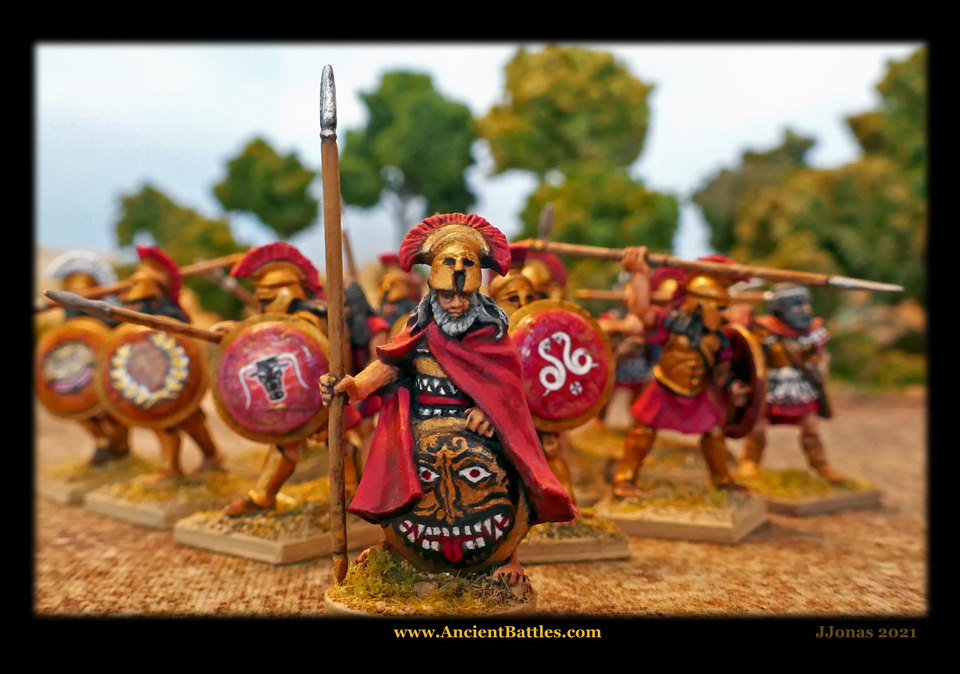
28mm
Spartan King by Gorgon Miniatures
Leonidas (c. 530-480 B.C.) a king of Sparta from about 490 B.C.
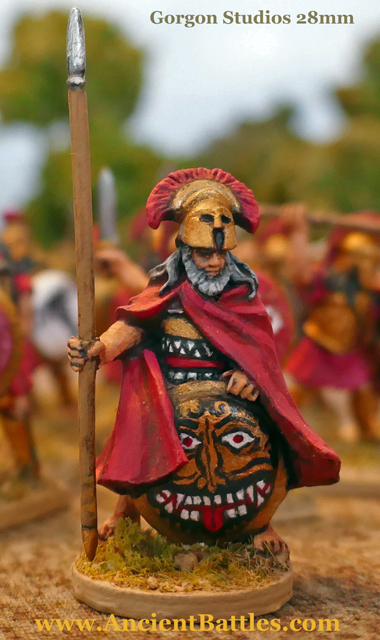
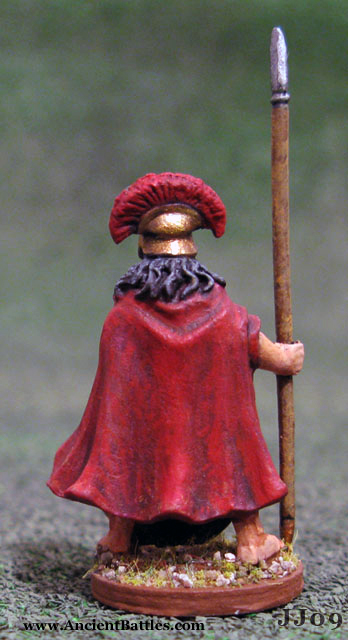
Gorgon Miniatures released a set of
Spartans sculpted by Steve Saleh a while back.
They are typical of Mr. Saleh's work, clean and nicely posed. I felt
the drapery on this one was very nice indeed.
The figure is a bit
large scale (jumbo) 28mm but is compatible with my
Wargames Foundry "World of the Greeks" and other older figures. I
changed out the oversized
sword and added a spear from a Vendel hoplite. It is a bit thick but
it is sturdy.
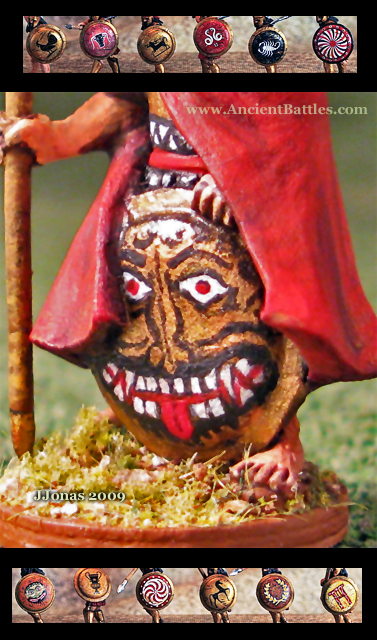
Painting
the Gorgon shield design is kind of fun, for a one-off! Leonidas
is
depicted with a Gorgon design on the statue at Sparta- so that's
good enough for me, although he might have used the scorpion (see
below).
Sometime later, during the Peloponnesian Wars, the Spartans began
switching to the lamda symbol to reduce
confusion against other Greeks. Blue on blue casualties happened.
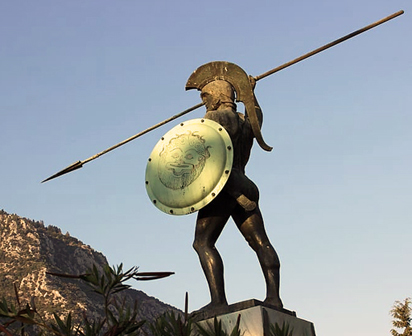
I just drew the
design on with a micron pen then painted over that, it's a little
rough when blown up and zoomed into...
but I prefer this to transfers, some of the Greek transfers
available today are far too gaudy for my tastes.
I changed this figure
by exchanging a spear for the sword, since I'm fickle about such
things.
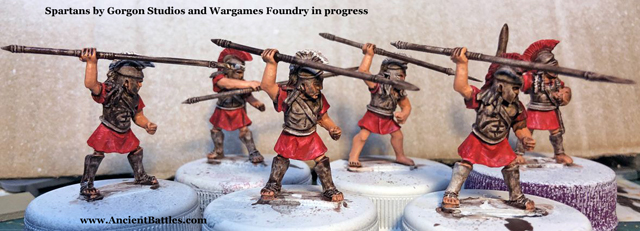
Here are some
of the figures (above) in progress. After priming with white, I
block in the armor with a dark brown tint shade
(mixed paint and matt Modge Podge, which makes a contrast color
tint). Then the flesh base and tunic color is applied.
The bronze is painted last after the figures are sprayed with matt
varnish. Some prefer to use the matt varnish to
Unlike the movies, and graphic novels, Leonidas
was at least fifty and
maybe older at Thermopylae.
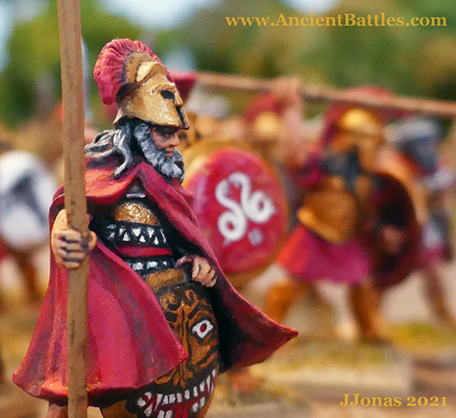
Gorgon
Studios Etruscan range is excellent as well, and can also be
used as early Greeks
Which I did for my Thermopylae Spartans with bronze bell armor.
Here's where you can get this and Gorgon Studios other Spartans and Etruscans:
http://www.gorgon-studios.com/
Another
Leonidas version, this time in 60mm. From the multi-pose Conte Toy
set.
Some say Leonidas may have used the Scorpion symbol, others say
Gorgon.
This is a cool toy set, and fun to paint. I had to scrape off the
lambda from the shield,
but I kept the (slightly) over done edging details. This dramatic
daylight setting (backyard) works well
for this larger model.
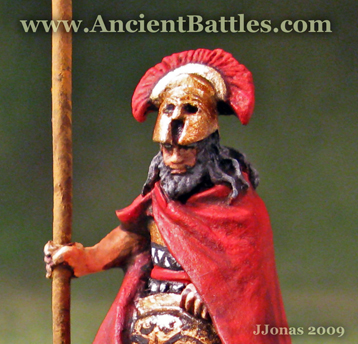
Inspiring
Thermopylae artwork
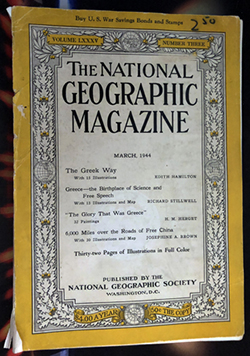
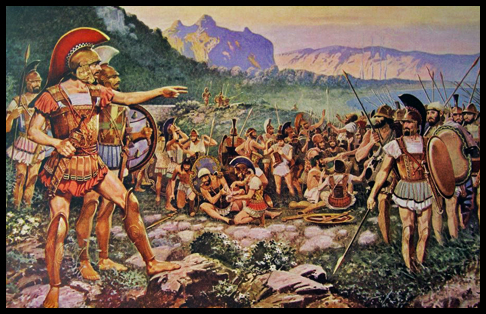
This
painting was one of my first exposures to the Thermopylae
story as a child, and it is from a National Geographic issue,
which was on my dad's shelf. This painting was is by H.M.
Herget, a prolific illustrator for National Geographic
in the 1930's and 1940's.
This appeared in the March 1944 National Geographic Magazine
"The Glory That Was Greece."
The caption is the famous quote: "Go tell the Spartans, oh
stranger passing by, that here, obedient to their laws, we
lie."
Here Leonidas on the left is telling the great majority of the
Greeks to retreat, since the pass has been outflanked.
His bodyguard of 300 Spartans and 700 Thespians (plus their
helots and attendants), made preparations to act as a
rear guard to allow the rest to escape. 400 Thebans also
stayed behind but we are told they surrendered to Xerxes'
Persians.
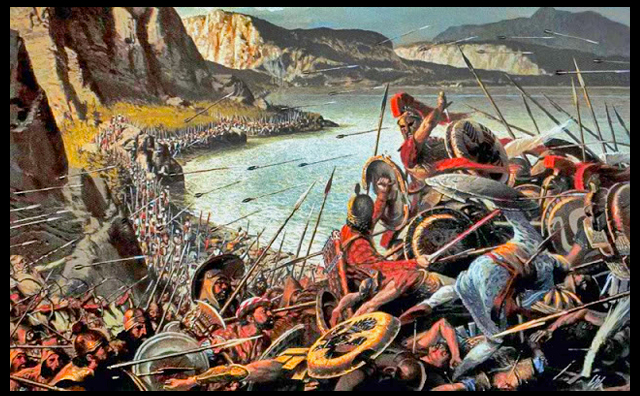
The
Last Stand at Thermopylae
This painting by Louis S. Glanzman "The Battle of Thermopylae"
is also from a National Geographic issue. Most folks remember
fondly (as I do) from the brilliant compilation book:
"Greece and Rome: Builders of Our World (The Story of Man)"
which was printed in 1977 and has never left my library since.
This is my favorite painting of Thermopylae because it
captures the sense of the dominance of the terrain, the
Persian overwhelming
odds over the Spartans, and the fierce resistance of the
armored and trained Greek hoplites, bolstered by the small
force of Spartans.
Despite their overwhelming numbers the Persians were unable to
break through the 7000 Greeks ensconced in the pass for days.
The defensive area was so narrow that the Greeks
took shifts and rotated the defense. Fresh hoplites were
available to stop each wave of Persians dashing themselves
against the Greek shield walls. Eventually, as the well told
story goes, a local man told the Persian King how to navigate
a narrow pass around the
Greeks, and their position was outflanked. The painting
captures the dramatic scene when the Spartans
were surrounded by the Immortals, while other Persian forces
are pushing along the coast.
The Spartans retreated to higher ground and made their last
stand. Leonidas was eventually killed and his Spartans fought
to the last man.
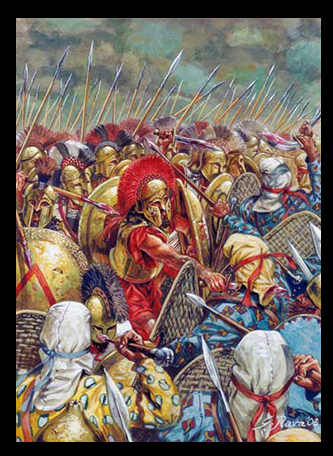
Feigned flight
This painting of "Leonidas at Thermopylae " is a modern work
by Giuseppe Rava. I have it on my wall.
It is an inspiring print and very much captures the fury as
the Spartans deliberately fell back and lured the Persians
into pursuing them.
Then the disciplined Spartans halted, about faced, locked
shields, and charged back into the surprised and disordered
Persian ranks scattering them,
even forcing some to fall over the cliff's edge. Mr. Rava
captures the violence and fury of the massed bronze armored
phalanx
unleashed on the lesser armored Persians whose wicker shields
were no match for the longer Greek spears, and bronze covered
shields.

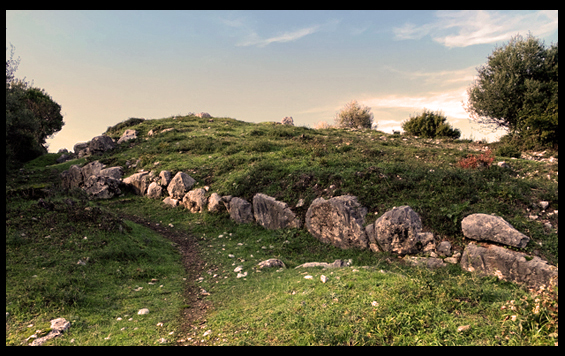
Thermopylae today,
is next to a major highway. The ocean has receded hundreds of
yards since 480 BC. The scrub covered hills remain,
and the rocks, and one can get an idea of the ground. It looks
so much like my native California. A lot of rocks, grasses,
dust, and chaparral.
This area is somewhere close to the Phocian wall, which was
the Greeks rallying point.
(Photos from the web: attribution needed).
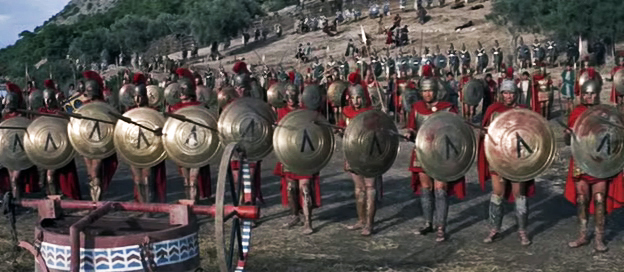
Don't forget
the helots! They were the equivalent of feudal serfs and backbone of
the Spartan army.
Helots carried the load, and food, so the Spartan hoplite could march
and fight.
They also served as psiloi (skirmishers) with rocks, javelins, and
occasional bows. Their numbers
and their dead are never recorded, each Spartan would have at least
one attendant.
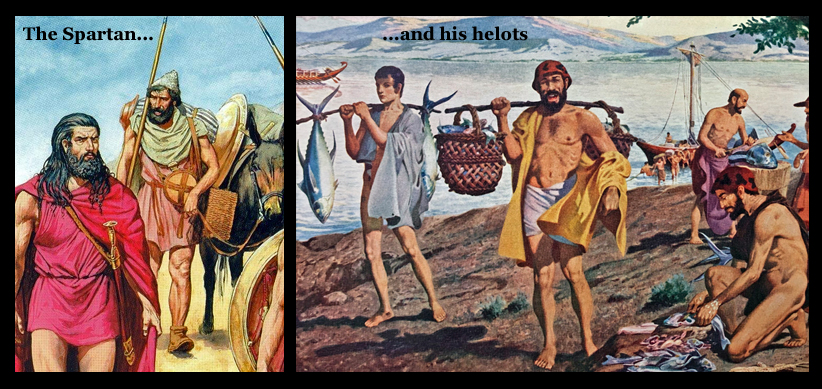
"Gates of
Fire" a novel by Steven Pressfield is an excellent work of
historical fiction, and great inspiration.
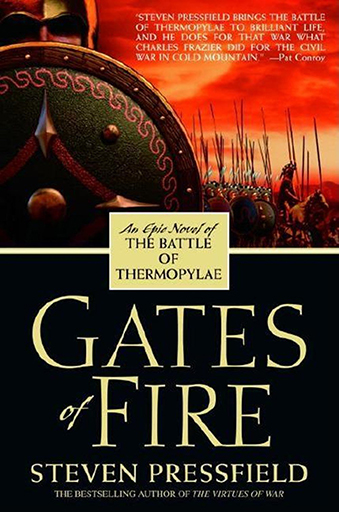
"In ''Gates of
Fire,'' Steven Pressfield gives the reader a perspective no ancient
historian offers, a soldier's-eye view.
The story is told by a witness to the battle... even after he has been
given permission to return home.
He survives the battle, but only long enough to dictate his account to
a Persian historian."
Mary
Lefkowitz, a professor of classics at Wellesley
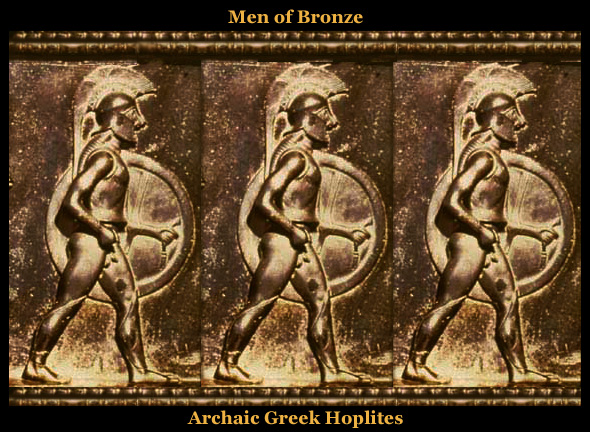
Back to AncientBattles.Com Home Page
09/01/09